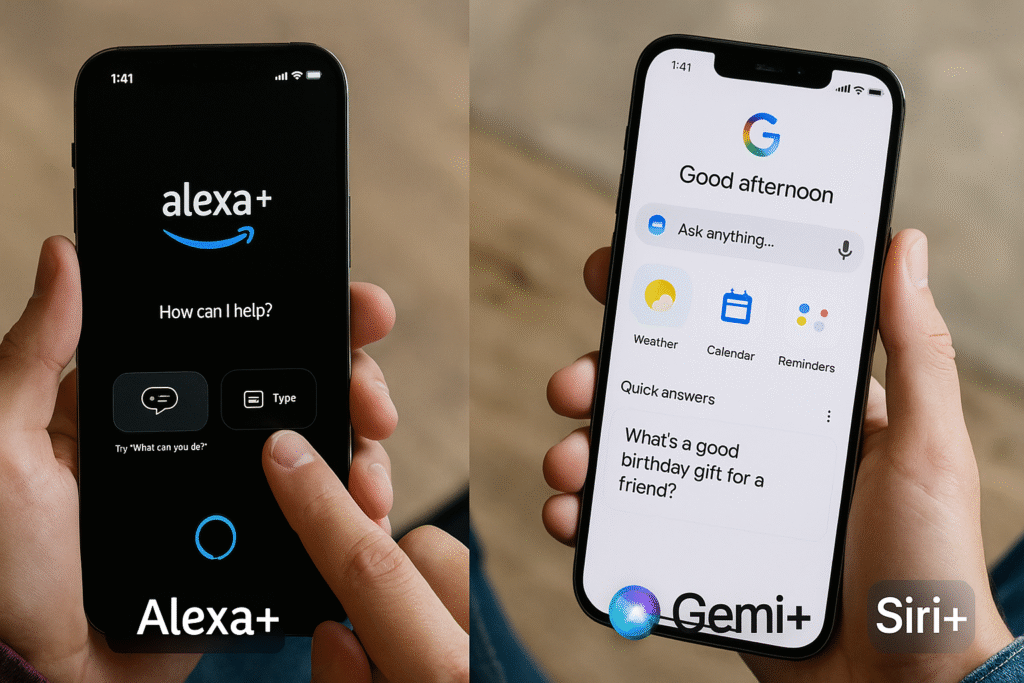6 Shocking Limits of Alexa+ on Smartphones
Alexa+ on Smartphones Introduction: A Smarter Alexa, But Not on Your Phone?
In the heated AI arms race of 2025, Amazon took a bold leap forward with its next-generation voice assistant: Alexa+. Built on large language models and infused with generative AI, this upgrade was pitched as a game-changer. Alexa+ was no longer just a tool for timers and playlists; it could hold nuanced conversations, recall past interactions, and even generate bedtime stories or email drafts on the fly. In the company’s own words, this was supposed to be Alexa’s most “intelligent, conversational, and proactive” evolution yet.
And for the most part, on Echo devices, it lives up to the hype. Early testers praised Alexa+ on the Echo Show 8 for its contextual awareness, dynamic memory, and ability to converse naturally over multiple turns. Amazon showcased scenarios where Alexa+ offered thoughtful follow-ups, generated grocery lists, explained recipes visually, and even created spontaneous, creative content, all with a human-like flow that rivaled ChatGPT and Google’s Gemini.
But then users tried Alexa+ on their phones.
And the experience? Well, let’s just say it was less magical.
Instead of a full-featured mobile assistant, many users encountered a watered-down version: missing promised features, limited app integrations, no visual or camera input, and persistent reliance on cloud connectivity for even basic tasks. It quickly became apparent that Alexa+ on smartphones is not yet the full AI experience Amazon promoted. Instead, it feels like a beta test polished on paper, but incomplete in practice.
This isn’t just a minor usability issue. With so many users relying on smartphones as their primary interface for AI assistants, Alexa+’s mobile limitations risk undermining Amazon’s broader vision. And in an era when Google’s Gemini is baked into Android, Apple is rolling out Siri+ with on-device reasoning, and ChatGPT lives in millions of phones via native apps, Alexa+ cannot afford to stumble where it should shine most: in your pocket.
So what’s holding it back?
In this article, we dive into six shocking limitations of Alexa+ on mobile devices. From privacy roadblocks to integration headaches and broken promises, we explore why Amazon’s AI powerhouse hasn’t yet found its footing on phones and what it needs to fix if it wants to compete in the next generation of voice-first, AI-driven experiences.
Why It Matters
On the surface, Alexa+ sounds like a powerful step forward in Amazon’s response to the booming AI assistant revolution. But when it fails to deliver a seamless experience on smartphones, the very foundation of its usefulness is put into question. And here’s why that matters more than many users or Amazon might realize.
1. The Smartphone Is the Default AI Hub
In 2025, the smartphone isn’t just another device; it’s the device. It’s where most users access voice assistants, manage smart home controls, search the web, message friends, plan calendars, and consume media. If Alexa+ can’t function fluidly on mobile, it’s effectively missing out on the core of modern digital life.
When your competitor’s AI is integrated natively into your browser, messages, camera, calendar, and photo app, and yours can’t even access Spotify without a workaround, you’re not just behind. You’re irrelevant.
2. Consumer Trust Depends on Feature Parity
Amazon made bold promises about Alexa+’s capabilities, but many of them don’t yet work on mobile, if at all. This breaks the trust consumers place in the brand. When people see demos of Alexa+ telling bedtime stories or offering creative writing help, they expect those features to be available wherever they use Alexa. Otherwise, the assistant becomes a source of frustration, not empowerment.
3. Smartphone Users Expect Privacy and Control
The inability to delete uploaded files, the reliance on cloud-only processing, and vague terms of data retention are red flags, especially for privacy-conscious users. As regulators in the EU, U.S., and Australia crack down on data use, these lapses could have legal consequences, not just bad PR.
In a world where Apple is building privacy into every layer of its AI and Google is making on-device processing the new standard, Amazon can’t afford to make trust an afterthought.
4. Mobile-First Markets Are the Growth Frontier
Emerging markets and younger users are mobile-first; many are mobile-only. If Alexa+ doesn’t work well on phones, Amazon is effectively locking itself out of massive future user segments. And as rivals build multilingual, low-bandwidth, app-integrated AI experiences optimized for mobile, Alexa+ risks becoming a niche Echo experience instead of a global platform.
In short, Alexa+ has massive potential, but that potential is muted if it can’t show up where people live: on their phones. For Amazon to stay in the AI race, Alexa+ needs to be more than impressive on a smart speaker; it needs to be reliable, responsive, and relevant in your pocket. Until that happens, Alexa+ may remain brilliant in the showroom, but broken in your hand.
1. Many “AI Features” Are Still Missing
Amazon promised a long list of futuristic features during Alexa+’s reveal: multimodal storytelling, Grubhub orders, smart reminders based on family facial recognition, and even long-form memory about user preferences.
But as of mid-2025, many of those features are still in development and completely absent from smartphones.
“Alexa+ has launched with a fraction of what was demoed… Most advanced features, like visual memory or dynamic assistant roles, are not yet live,” reports Tom’s Guide.
What this means: Users expecting a ChatGPT-style assistant on their phone are left waiting, possibly until late 2025 or even 2026.
2. Limited App Integration on Mobile
Unlike Google Assistant or Apple’s Siri Shortcuts, Alexa+ still struggles to connect meaningfully with third-party apps on smartphones.
Only a small number of apps support “Alexa for Apps,” which enables deeper mobile actions like opening YouTube searches or booking rides through voice commands.
According to Amazon’s developer documentation, this functionality is “currently limited to select Android experiences and developer opt-ins.”
Bottom line: You can’t count on Alexa+ to control Spotify, WhatsApp, or your productivity apps at least not in the seamless way other assistants do.
3. No Offline Functionality
In an era where AI models like Gemini Nano and Apple’s on-device Intelligence are powering voice commands even without internet, Alexa+ still requires a full online connection for everything, even basic commands.
If you’re out of data or on a poor connection, Alexa+ will simply fail to respond.
“There is currently no offline fallback for Alexa+, which significantly reduces its practicality compared to rivals,” notes Lifewire.
In short, Alexa+ on your phone is smart but only when it’s online. And that’s a big problem for mobile users on the go.
4. Privacy Limitations and No Easy Data Deletion
Here’s a big one: when you upload documents or personal info into Alexa+ via mobile, there’s no simple way to delete them from the app.
Users have reported that to remove stored files or personalized content, they need to manually contact Amazon customer support, a far cry from transparent privacy controls.
As Neowin points out, “The lack of self-service data deletion tools raises concerns, especially for a generative AI model that can retain context.”
That’s more than inconvenient; it’s a potential privacy risk.
5. No Visual Recognition or Camera Features Yet
One of Alexa+’s most exciting future features is the ability to visually recognize family members, objects, or pets and respond with contextual, personalized prompts. This is similar to what Google’s Gemini and Apple’s Vision Pro can do today.
But on smartphones? This feature simply isn’t available.
“Despite marketing material, Alexa+ does not currently use the camera for visual memory on mobile devices,” confirms Tom’s Guide.
So if you were hoping to scan a product with your camera and have Alexa+ describe it forget it. That’s still Echo-only.
6. No Web or Desktop Access to Alexa+ Yet
Unlike OpenAI (which lets you access ChatGPT from a browser or desktop) or Google’s Gemini (which integrates directly into Chrome), Alexa+ has no web-based experience at this time.
A 2025 Verge article notes that “web access to Alexa+ is under consideration but not available at launch.”
That means your smartphone is the only non-Echo gateway to Alexa+ and even then, with reduced capabilities.
Final Thoughts: Alexa+ Needs to Catch Up on Mobile

Alexa+ is undeniably a step forward for Amazon in the generative AI race. Its potential for deep conversations, dynamic reminders, and long-term memory is real, and on Echo devices, it shines.
But on smartphones?
It’s a very different story.
With limited features, app integration gaps, online-only functionality, and serious privacy management hurdles, Alexa+ still feels like a rough draft for mobile users. And as rivals like Google Gemini and Apple Intelligence race ahead with native, context-aware, and offline-friendly assistants, Amazon has work to do.
Until Alexa+ catches up, mobile users may want to stick with other tools for their on-the-go AI needs.
